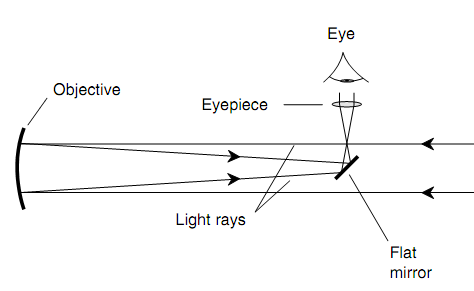Newtonian Reflector:
Sir Isaac Newton planned a reflecting telescope which was free of chromatic aberration. His design is yet used in most of the reflecting telescopes nowadays. The Newtonian reflector utilizes a concave objective mirror build up at one end of a long tube. The other end of the tube is open to confess incoming light. The small, flat mirror is mounted at a 45° angle close to the open end of the tube to reflect the focused light via an opening in the side of the tube having the eyepiece (as shown in figure below).

Figure: The Newtonian reflector consists of an eyepiece set into the side of the tube.
The flat mirror blocks some of the incoming light, a little decreasing the effective surface region of the objective mirror. Since a typical illustration, assume that a Newtonian reflector contains an objective mirror 20 cm in diameter. The total surface area of the mirror is around 314 centimeters squared (cm2). When the eyepiece mirror is a 3-cm square, its total area is 9 cm2 that is around 3 percent of the total surface area of the objective.
The Newtonian reflectors have limitations. Some of the people find it not natural to "look sideways" at objects. Whenever the telescope has a long tube, it is essential to use a ladder to view objects at high elevations. Such annoyances can be overcome by using a different manner to get the light to the eyepiece.